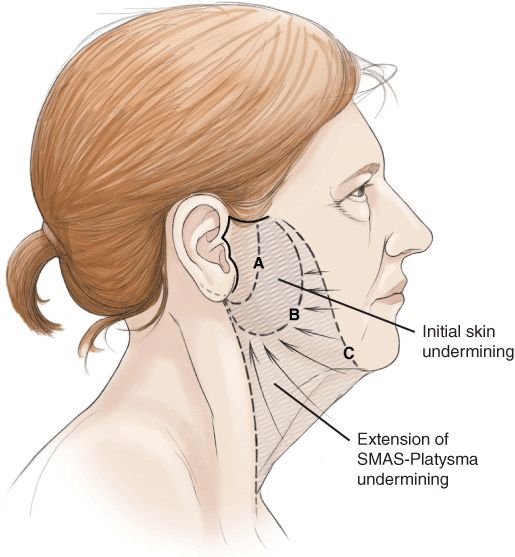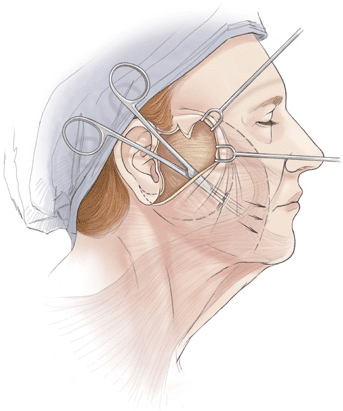Chapter 15. Short-Scar Facelift I
Hamid Massiha, MD
INDICATIONS
The technique of short-scar facelift is indicated in the entire spectrum of face and neck aging. Exceptions are uncommon and are limited to extreme aging and deformities unrelated to aging. In younger individuals, dissection is less extensive and could be more extensive as aging deformity is more advanced.
PREOPERATIVE PREPARATION
Patients are checked thoroughly for preexisting medical conditions. Standard, age-appropriate laboratory tests are done. If needed, medical clearance from their treating physicians is obtained. Anticoagulants are discontinued 10 days prior to surgery. Smokers are advised to discontinue smoking and use of all nicotine-containing substances, including gum and patches, at least 2 to 3 weeks preoperatively.
ANESTHESIA
Typically, general endotracheal anesthesia is recommended. However, this procedure could easily be done under local anesthesia with sedation especially in cases in patients with minimal skin ptosis. Local anesthesia with epinephrine is also injected (see details of procedure), allowing adequate time for the epinephrine to work. Because this maneuver minimizes bleeding, often, no hemostasis is required and no drains are needed.
POSITIONS AND MARKING
Markings are made at the preoperative holding area with the patient in a sitting position. This gives us one last chance to evaluate the patient’s individual needs. Technical variances are made to accommodate each patient’s case (Fig. 15-1).

Figure 15-1 Preoperative markings. Line A: Initially some skin is removed. Line B: Skin dissection. Line C: SMAS-platysma dissection.
The operation is done with the patient in the supine position. We usually do not use a headrest unless the patient has a neck problem. An extended neck may help in the judgment of the effectiveness and the efficiency of the vectors of traction.
DETAILS OF PROCEDURE
With the patient under appropriate anesthesia and in the supine position, the face and neck area is prepped and draped by the surgeon. The endotracheal tube is marked at the level of the front teeth and is held up until the sterile drape is placed under it. Next, the endotracheal tube is placed over an open blue cloth towel, which is then wrapped around the tube and fixed with a clamp to hold it on the patient’s chest, thus holding the tube at the mid-line, out of the way of the surgeon yet readily available to the anesthesia personnel. This detail in draping gives direct access to the neck area. The endotracheal tube can be moved from one side to the other if central neck intervention is needed.
The operation is started by first infusing a total of 100 mL of a mixture of 0.5% lidocaine with epinephrine and 0.25% bupivacaine hydrochloride with epinephrine (50 mL per side). Adequate time should be allowed for the epinephrine to be effective (a minimum of 20 minutes). This minimizes bleeding to a level that makes the need for hemostasis rare. Suction drains are not usually necessary.
After deciding which side to do first (see Pearls section), the incision is made at the preauricular area. The incision travels in a manner that it follows the anatomical curves and it passes right at the top of the tragus (not inside of it) and is turned around the ear lobule. Usually, the identification of the superficial musculoaponeurotic system (SMAS) is facilitated if a strip of skin and fibro-fatty tissue is removed initially from the preauricular area.
Skin dissection is done anteriorly toward the nose and nasolabial fold. As dissection turns toward the inferior aspect, it is limited to approximately 4 to 5 cm and very limited as dissection approaches the area under the ear lobule (Fig. 15-2).

Figure 15-2 Skin dissection completed. Scissors are under SMAS dissecting. SMAS-platysma layer.
Stay updated, free articles. Join our Telegram channel

Full access? Get Clinical Tree








